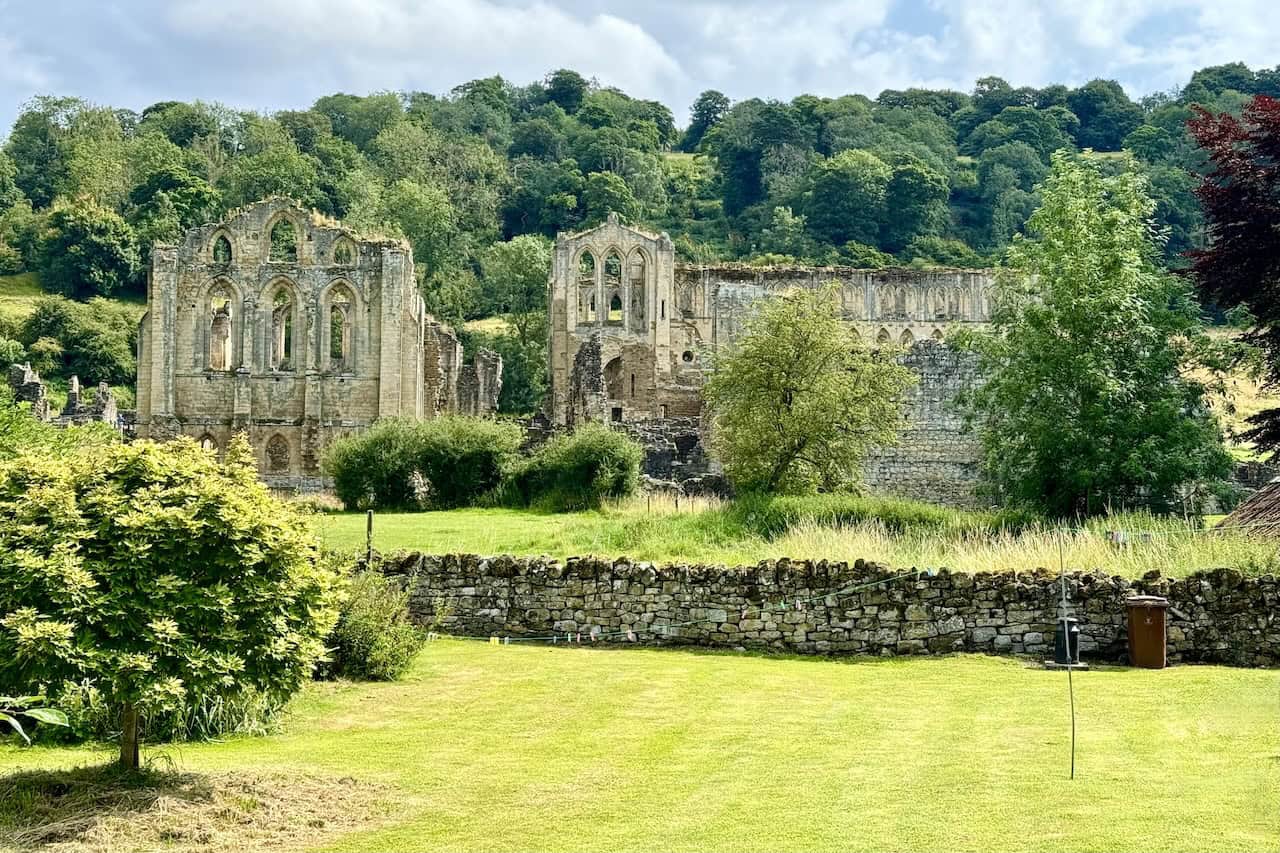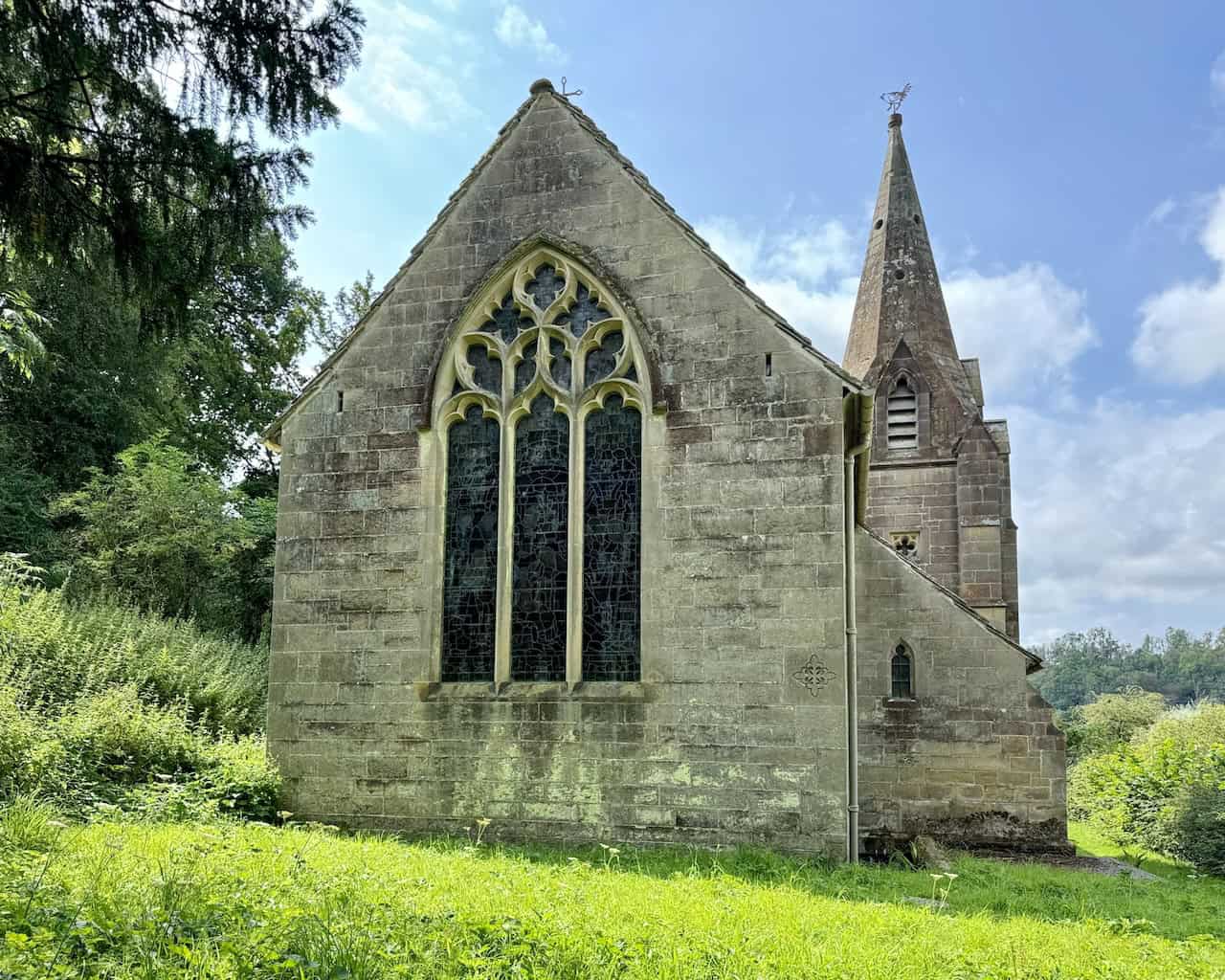Explore Historic Trails on the Helmsley to Rievaulx Abbey Walk in Yorkshire
This Helmsley to Rievaulx Abbey walk offers a delightful trek through the scenic North York Moors, suitable for walkers of all ages and abilities. The linear route covers just over 3¼ miles (5.2 kilometres) each way, making for a round trip of approximately 6½ miles (10.4 kilometres). Starting in Helmsley, you’ll journey to St Mary’s Church in the village of Rievaulx before retracing your steps back to Helmsley.
Begin your Helmsley to Rievaulx Abbey walk in Helmsley town centre, parking at the Cleveland Way Car Park. To find the car park, turn off the B1257 main road on the town’s west side. Exit the car park via the main entrance, passing the public toilets on your right. Upon reaching the road known as Cleveland Way, turn left. You’ll soon pass the prominent triangular-shaped Cleveland Way National Trail stone monument on your left, marking the start of your journey along this famous trail.

Continue westward from the monument, following a path that initially crosses open fields before running alongside Blackdale Howl Wood. After walking just over a mile (1.6 kilometres), you’ll enter Blackdale Howl Wood, where you’ll descend a set of steps into a small ravine and then ascend another set to exit the wood. Stay on the well-defined track, which will lead you to Griff Lodge at the top of Jinny York Bank. Pass to the left of the lodge, keeping to the Cleveland Way National Trail route.
As you leave Griff Lodge, the trail enters Whinny Bank Wood. Follow the path downhill through Quarry Bank Wood until you reach a minor road, roughly three-quarters of a mile (1.2 kilometres) from the lodge. At the road, turn left and descend the hill. Initially, a narrow path runs alongside the road, but it soon disappears. However, the road is generally quiet, so continue along it for just under half a mile (0.8 kilometres) until you reach Rievaulx Bridge.

At this point, you will leave the Cleveland Way National Trail. Instead of crossing Rievaulx Bridge, turn right and follow the road north, signposted for the Rievaulx Abbey Ancient Monument. As you proceed, you’ll see the abbey on your right. Continue past the abbey’s entrance, where you’ll find a café and toilets if needed. The route takes you into the village of Rievaulx, where you’ll pass a picturesque thatched cottage on your left and then St Mary’s Church on your right.
The church marks the halfway point of your Helmsley to Rievaulx Abbey walk, roughly 3¼ miles (5.2 kilometres) from the start. From here, simply turn around and follow the same route back to Helmsley. This beautiful walk through the Rye Dale area of the North York Moors offers a fantastic experience for the whole family. Enjoy the stunning scenery and the sense of history along the way.
Helmsley to Rievaulx Abbey Walk: Maps and Tools
Visit either the OS Maps website or the Outdooractive website to view this walking route in greater detail. Both platforms offer a range of features, including the ability to print the route, download it to your device, and export the route as a GPX file. You can also watch a 3D fly-over and share the route on social media.
Helmsley to Rievaulx Abbey Walk: Distance, Duration, Statistics
Distance: 6½ miles
Distance: 10½ kilometres
Duration: 3 hours
Ascent: 748 feet
Ascent: 228 metres
Type: Linear walk

Recommended Ordnance Survey Map
The best map to use on this walk is the Ordnance Survey map of the North York Moors Western Area, reference OS Explorer OL26, scale 1:25,000. It clearly displays footpaths, rights of way, open access land and vegetation on the ground, making it ideal for walking, running and hiking. The map can be purchased from Amazon in either a standard, paper version or a weatherproof, laminated version, as shown below.
About Rievaulx Abbey
Rievaulx Abbey, nestled near Helmsley in the North York Moors National Park, North Yorkshire, was a renowned Cistercian abbey. Established in 1132, it became one of England’s significant abbeys until its dissolution in 1538 under Henry VIII. The site received Scheduled Ancient Monument status in 1915 and came under the care of the Ministry of Works in 1917. Today, English Heritage maintains the ruins of this historic site, making it a popular tourist attraction.
The Foundation of Rievaulx Abbey
The abbey was the first Cistercian monastery in Northern England, founded by twelve monks from Clairvaux Abbey. Its remote location reflected the order’s commitment to a life of prayer and self-sufficiency, with minimal contact with the outside world. The abbey’s patron, Walter Espec, also established Wardon Abbey in Bedfordshire, further showcasing his dedication to the Cistercian way of life.
Under the leadership of its first abbot, William I, and later Saint Aelred of Rievaulx, the abbey expanded significantly. It became one of the largest Cistercian abbeys in Yorkshire, second only to Fountains Abbey. During Aelred’s tenure, the community grew to around 140 monks and 500 lay brothers, establishing five daughter houses in England and Scotland.
The Financial Prosperity and Decline of Rievaulx Abbey
Rievaulx Abbey flourished due to its strategic location by the River Rye and the ingenuity of its monks. They altered the river’s course to create suitable building land and engaged in profitable ventures such as mining lead and iron ore, sheep farming, and wool trading. At its height, the abbey owned 6000 acres (2400 hectares) of land and was among the wealthiest in England.
However, the abbey’s fortunes waned in the late 13th century. Building debts, a sheep epidemic, Scottish raids, and the Black Death all contributed to its decline. By 1381, the community had dwindled to fourteen choir monks, three lay brothers, and the abbot. The once-strict Cistercian practices were relaxed, with monks enjoying a more comfortable lifestyle and private living accommodations.
The Dissolution of Rievaulx Abbey
In 1538, during the Dissolution of the Monasteries, the abbey faced significant changes. The abbot and 21 monks inhabited 72 buildings, with 102 lay employees supporting them. The abbey had an annual income of £351 and even operated a prototype blast furnace at Laskill. However, the confiscation of monastic properties led to the destruction of the abbey’s buildings, which were stripped of valuable materials like lead. The site was granted to Thomas Manners, 1st Earl of Rutland, and later passed to the Duncombe family.
The Post-Monastic Era and Preservation of Rievaulx Abbey
Rievaulx Abbey’s story continued into the 16th and 17th centuries when it became an important iron-manufacturing site. In the 1750s, Thomas Duncombe III enhanced the estate’s beauty by creating a terraced walk with views of the abbey ruins. Two Grecian-style temples, now managed by the National Trust, were added to this picturesque landscape.
In the 1920s, the abbey contributed to the restoration of York Minster’s Five Sisters window by donating lead stripped from its windows after the Dissolution. Today, English Heritage cares for the abbey ruins, and the site has become a significant historical monument.
Modern Discoveries and the Legacy of Rievaulx Abbey
In recent years, archaeological surveys have deepened our understanding of Rievaulx Abbey. A 2015 study commissioned by Historic England used aerial photography and ground-based surveys to explore the abbey precinct. The findings were published in 2019, shedding new light on the landscape surrounding the abbey.
Rievaulx Abbey’s legacy continues to inspire, as evidenced by former Prime Minister Harold Wilson’s choice of the title ‘Baron Wilson of Rievaulx’ when awarded a life peerage in 1983. This historic site remains a testament to England’s rich monastic history and the enduring appeal of its architectural and natural beauty.
My Helmsley to Rievaulx Abbey Walk
For those keen to explore this historic site, my Helmsley to Rievaulx Abbey walk offers a scenic and enriching experience. This walk allows visitors to immerse themselves in the natural beauty and historical significance of the region, making it a must-visit destination in North Yorkshire.
If you’re looking for more walking routes in the area, you might enjoy another one of my walks starting from Helmsley and passing Rievaulx Abbey. It’s a longer route, and you can find the details on my website at https://www.paulbeal.com/rievaulx-abbey-walk. This route offers a different perspective on the stunning landscape and rich history of the area.
Helmsley to Rievaulx Abbey Walk: My Photos
A triangular stone monument at the Cleveland Way Car Park in Helmsley town centre marks the start of the Cleveland Way National Trail. This trail stretches 109 miles (175 kilometres) to Filey. The monument is inscribed with the names and distances of key locations along the trail, starting from Helmsley. The Helmsley to Rievaulx Abbey walk also begins here, heading in the same direction as the national trail.

Starting from the stone monument in Helmsley, the path initially heads west across open fields towards Blackdale Howl Wood. This route is easy to follow, with a smooth, navigable surface that is suitable for walkers of all abilities. A large oak tree stands on the right-hand side of the path.

The path skirts along the northern edge of Blackdale Howl Wood. Upon entering the wood, a moss-covered tree stump can be seen at the top of a set of stone steps. The path then descends into a small ravine before ascending on the other side.

These are the stone steps leading out of the ravine, marking the point where the path leaves Blackdale Howl Wood.

Beyond Blackdale Howl Wood, the Helmsley to Rievaulx Abbey walk passes in front of Griff Lodge, a distinctive stone building situated at the top of Jinny York Bank.

From Griff Lodge at the top of Jinny York Bank, there is a breathtaking panoramic view of the surrounding landscape.

Continuing west from Griff Lodge, the walk follows the northern boundary of Whinny Bank Wood. The path is lined with tall trees, creating a pleasant and family-friendly environment.

After leaving Whinny Bank Wood, the walk continues north-west and descends through Quarry Bank Wood. The stone-covered path, flanked by a mix of slender and sturdy tree trunks, remains part of the Cleveland Way National Trail and is easy to navigate.

At the bottom of the path through Quarry Bank Wood, the route takes a left turn onto a tarmac road. Initially, there is a narrow footpath on the left side, but it soon disappears around a bend.

Just before the footpath ends, a sign warns that there is no footway for one mile. However, the road is generally quiet, with few cars passing by, requiring only a bit of caution. The road curves around and leads to Rievaulx Bridge.

Along the way to Rievaulx Bridge, a charming countryside scene unfolds, featuring a stone cottage with a red-tiled roof, surrounded by colourful flowers and tall grasses. A hill covered with dense trees forms the backdrop.

Shortly after passing the stone cottage is Rievaulx Bridge. However, the walk does not cross it. Instead, it follows the road to the right, as indicated by a signpost for the Rievaulx Abbey Ancient Monument. This is where the Helmsley to Rievaulx Abbey walk temporarily diverges from the Cleveland Way National Trail.

Rievaulx Bridge spans the River Rye, a short river of about 20 miles (32 kilometres) that originates on Snilesworth Moor and flows into the River Derwent near Malton. There is a delightful spot beside the bridge, perfect for a rest or a snack.

From Rievaulx Bridge, the walk continues north along a narrow road leading into the village of Rievaulx. The road runs parallel to the River Rye on the left.

Walking towards the village of Rievaulx, the abbey comes into view on the right-hand side. In the trees behind the abbey, one of the temples on Rievaulx Terrace is just visible.

Zooming in, Rievaulx Abbey reveals its stunning stonework and arched windows. The surrounding greenery provides a vibrant contrast to the weathered stone.

Continuing north along the road, just after passing the entrance to the abbey’s visitor centre on the right, a broader view of Rievaulx Abbey appears, set against a backdrop of lush trees and rolling hills. It’s worth noting that the visitor centre includes a café and toilet facilities.

Further along, after the abbey, on the left, stands a quaint traditional English cottage with a thatched roof. This charming cottage is likely a popular subject for photographers.

At the northern end of the village of Rievaulx stands St Mary’s Church, a Grade II listed building. This small stone church, featuring a pointed spire and a large Gothic-style window with intricate tracery, once served as the slipper chapel for Rievaulx Abbey, where pilgrims would remove their footwear before completing their pilgrimage.

After exploring the village of Rievaulx, it’s time to turn back. At Rievaulx Bridge, the River Rye is joined by a small stream that flows through the gardens of a private residence.

Now back on familiar ground, the walk returns to Helmsley along the Cleveland Way. The pleasant countryside paths are suitable for families, offering an enjoyable experience for parents, grandparents, and children alike.

Passing Griff Lodge once more, the walk continues across the top of Jinny York Bank.

Returning to Blackdale Howl Wood, it’s time to navigate the stone steps down into the small ravine and then ascend again. It might feel slightly more challenging with tired legs!

As the walk nears its end, the Cleveland Way leads back into Helmsley, providing a great view of Helmsley Castle on the right.

The Helmsley to Rievaulx Abbey walk concludes at the Cleveland Way stone monument. The monument lists the names of key locations along the trail, including Sutton Bank, Osmotherley, Cleveland Hills, Kildale, Roseberry Topping, Saltburn, Staithes, Whitby, Robin Hood’s Bay, Ravenscar, Scarborough, and Filey.

Amazon’s Top Walking Boots: Four Standout Choices for Men and Women
For walking and hiking, the right boots are essential for both comfort and safety. While Amazon boasts a wide range, certain boots emerge as top-sellers. From those, here are four I personally favour. As an Amazon affiliate, I may earn a small commission from any purchases made through the links provided. This helps support the upkeep of this website. Rest assured, you won’t pay a penny extra, but your purchase will contribute to keeping my site running smoothly. Happy walking!

Berghaus Men’s Hillmaster II Gore-Tex Walking Boots
These fully waterproof leather walking boots feature a Gore-Tex lining, ensuring no water enters whilst allowing feet to breathe and stay cool. Made from full-grain leather, they promise unmatched durability and comfort. The boots come with memory foam tongues and cuffs that mould to your feet for a tailored fit, and the Vibram Hillmaster outsoles offer confidence on challenging terrains.

Salewa Men’s Mountain Trainer Mid Gore-Tex Walking Boots
Made from durable suede and abrasion-resistant textile, these men’s hiking boots are both lightweight and sturdy. The upper material is enhanced by a 360° full rubber sheath. Their dual-layer midsole with Bilight technology ensures ergonomic cushioning and grip, especially on extended hikes. The Vibram Wrapping Thread Combi outsoles allow a natural walking feel, and the Gore-Tex lining provides waterproofing, breathability, and optimal weather protection. Furthermore, the patented Salewa 3F system ensures flexibility, a secure heel grip, and a blister-free fit.

Berghaus Women’s Supalite II Gore-Tex Walking Boots
Specially designed for women, these hiking boots offer waterproofing and breathability, thanks to their Gore-Tex lining. Crafted from full-grain abrasion-resistant leather, they’re durable enough for the toughest hikes. The Supalite soles ensure stability and traction, and the EVA midsoles add comfort for extended walks.

Merrell Women’s Moab 3 Mid Gore-Tex Walking Boots
These hiking boots incorporate a Gore-Tex waterproof membrane, blending breathability with superior waterproof performance. The combination of pigskin leather and mesh on the uppers, along with the suede outer material, ensure durability and style. Enhancements include 100% recycled laces, webbing, and mesh lining. Additionally, bellows tongues, protective toe caps, and Vibram TC5+ rubber soles ensure protection and ease on any terrain.